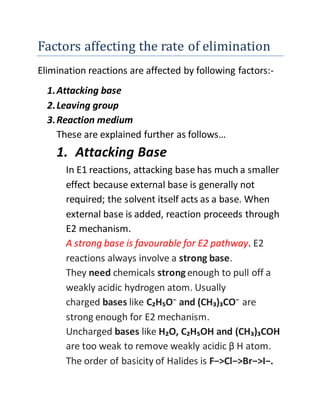
Factors affecting the rate of elimination
- 1. Factors affecting the rate of elimination Elimination reactions are affected by following factors:- 1.Attacking base 2.Leaving group 3.Reaction medium These are explained further as follows… 1. Attacking Base In E1 reactions, attacking base has much a smaller effect because external base is generally not required; the solvent itself acts as a base. When external base is added, reaction proceeds through E2 mechanism. A strong base is favourable for E2 pathway. E2 reactions always involve a strong base. They need chemicals strong enough to pull off a weakly acidic hydrogen atom. Usually charged bases like C₂H₅O⁻ and (CH₃)₃CO⁻ are strong enough for E2 mechanism. Uncharged bases like H₂O, C₂H₅OH and (CH₃)₃COH are too weak to remove weakly acidic β H atom. The order of basicity of Halides is F−>Cl−>Br−>I−.
- 2. Which means that Fluoride ion is the most basic of all and it will be most precise for attacking the alkyl halide in E2 pathway. General concept is The more basic the attacking base, the more faster the E2 reaction. 2. Leaving Group The role of leaving group in elimination reactions is similar to that in the substitution reactions. Reaction speeds up with a good leaving group. This is because the leaving group is involved in the rate-determining step. A good leaving group wants to leave so it breaks the C- Leaving Group bond faster. Once the bond breaks, the carbocation is formed and the faster the carbocation is formed, the faster the attacking base can come in and the faster the reaction will be completed. A good leaving group is a weak base because weak bases can hold the charge. They're happy to leave with both electrons and in order for the leaving group to leave, it needs to be able to accept electrons. Strong bases, on the other hand, donate electrons which is why they can't be good leaving groups. As you go from left to right on the periodic table, electron donating ability decreases and thus ability to be a good leaving group increases. Halides are an example of a good leaving
- 3. group whose leaving-group ability increases as you go down the column. Since carbocation is formed during E1 reactions, so when a good L.G is present it will leave the substrate easily, forming a carbocation faster and meanwhile promoting the E1 mechanism. Whereas a poor L.G favours the E2 mechanism. 3. Reaction Medium The most simple concept is that when there is a polar solvent, it will definitely promote the species that is more charged or polar. Because a polar solvent has the ability to stabilize the charged carbocation intermediate, therefore, a polar solvent will favour the E1 mechanism as it involves an ionic intermediate i.e; carbocation. The highly positive and highly negative parts interact with the substrate to lower the energy of the intermediate. Since the carbocation is unstable, anything that can stabilize this even a little, will speed up the reaction. Since there is no
- 4. such intermediate involved in E2 mechanisms, only a transition state is present, therefore, these will be promoted by rather a non-polar solvent. Examples of polar protic solvents are: acetic acid, isopropanol, ethanol, methanol, formic acid, water, etc.